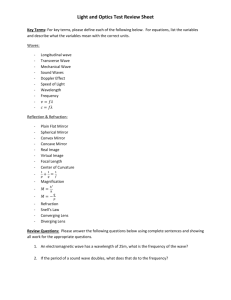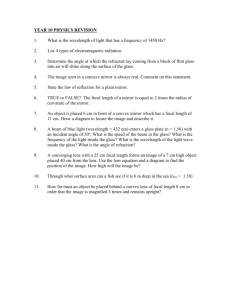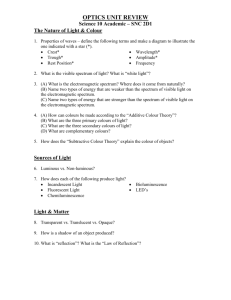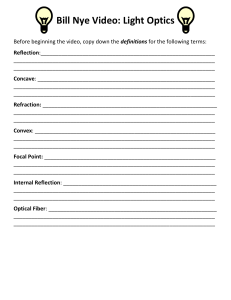Convex Mirrors
advertisement
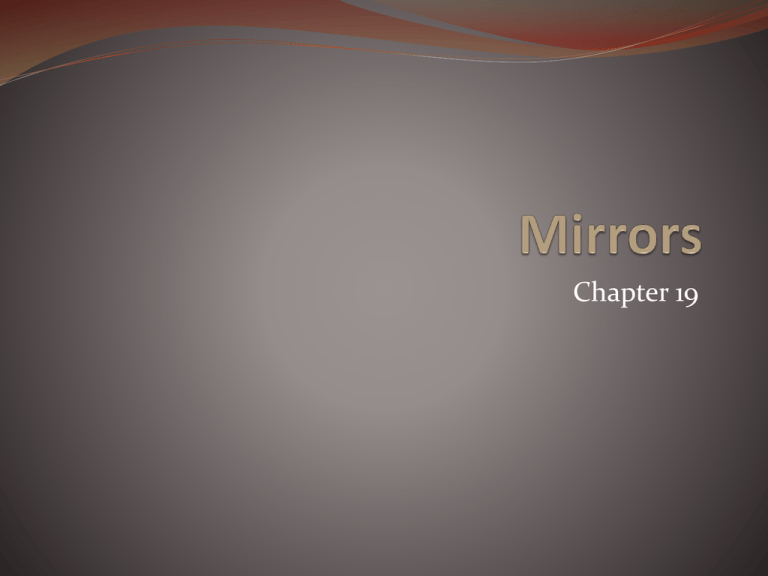
Chapter 19 Reflection The smooth surface of the lake reflects light rays so that the observer sees an inverted image of the landscape. Law of Reflection The law of reflection states that the angle of reflection is equal to the angle of incidence. Angle of Incidence & Reflection The angle of incidence is the angle the incident ray makes with a line drawn perpendicular to the surface of the mirror. The angle of reflection is the angle the reflected ray makes with the perpendicular line. Incident ray The flat (plane) mirror and the mirror-like lake surface both obey the law of reflection. Angle of incidence Angle of refraction Refracted ray Plane Mirror A plane mirror always produces a virtual image. A virtual image is a copy of an object formed at the location from which the light rays appear to come. A mirror with a flat surface is a plane mirror. When you look into a plane mirror, you see your reversed reflection—a right-left reversed image of yourself. Plane Mirrors To produce your image in a mirror, rays of light strike you and reflect. • The reflected rays strike the mirror and are reflected to your eyes. • The rays appear to come from behind the mirror. • Your image appears the same distance behind the mirror as you are in front, and the image is right side up. Concave vs Convex Concave mirrors can form either real or virtual images. Convex mirrors always cause light rays to spread out and can only form virtual images. Concave Mirrors Concave Mirrors When the inside surface of a curved mirror is the reflecting surface, the mirror is a concave mirror. • The curvature of the reflecting surface causes the rays to come together. • The point at which the light rays meet is called the focal point. Concave mirrors in automobile headlights and flashlights direct the illumination from a light bulb into a beam. Concave Mirrors The type of image formed depends upon where the object is in relation to a concave mirror. When the object is farther from the mirror than the focal point, the reflected rays meet in front of the mirror to form a real image. • A real image is a copy of an object formed at the point where light rays actually meet. • Unlike a virtual image, a real image can be viewed on a surface such as a screen. Images When the object is closer to the mirror than the focal point is, the reflected rays spread out and appear to come from behind the mirror to form a virtual image. Concave Mirror Parallel incoming rays are reflected through the focal point of a concave mirror. Focal point Concave mirror Concave Mirror Real images form when the reflected light rays converge. Focal point Concave mirror Concave Mirror Virtual images form when the reflected rays appear to come from a point behind the mirror. Focal point Concave mirror Convex Mirrors Convex Mirrors When the outside surface of a curved mirror is the reflecting surface, the mirror is a convex mirror. • The curvature of the convex mirror causes the reflected rays to spread out. The image formed by a convex mirror is always upright and smaller than the object. • A convex mirror shows a wide angle of view. • Convex mirrors can only form virtual images. Convex Mirror Parallel incoming rays are reflected away from one another by a convex mirror. Focal point Convex mirror Convex Mirror The virtual images are upright and smaller than the object. Focal point Convex mirror Lenses When light enters a new medium at an angle, the change in speed causes the light to bend, or refract. Light usually travels in straight lines. In a vacuum, light travels at a speed of 3.00 × 108 meters per second. • The speed of light in a different medium depends on the material of the new medium. • Air allows light to pass through almost as fast as it would through a vacuum. Index of Refraction A light ray bends (refracts) as it passes through media with different indices of refraction. The ray again travels in its original direction when it reenters the air. Index of Refraction The amount of refraction depends upon the difference between the speeds of light in the two media. The index of refraction for a material is the ratio of the speed of light in a vacuum to the speed of the light in the material. • A low index of refraction (near 1) causes light to slow and refract very little. • Diamond (index of refraction = 2.42), causes significant refraction. Lenses Concave lenses always cause light rays to spread out and can only form virtual images. Convex lenses form either real or virtual images. Concave Lenses Concave Lenses A lens is an object made of transparent material that has one or two curved surfaces that can refract light. A concave lens is curved inward at the center and is thickest at the outside edges. Concave Lenses When parallel incoming rays strike a concave lens, they are refracted away from one another. Optical axis Focal point Concave lens Concave Lenses As the light rays diverge after passing through the concave lens, they form a virtual image of the object. Object Focal point Virtual image Concave lens Focal point Convex Lenses Convex Lenses A convex lens is curved outward at the center and is thinnest at the outer edges. • As the rays pass through the lens, each one is refracted, and they emerge at different angles. • Convex lenses cause incoming parallel rays to come together, or converge. Convex Lenses Parallel rays are refracted and pass through the focal point of a convex lens. Focal point Optical axis Convex lens Convex Lenses When an object is located beyond the focal point, a real image is formed. Focal point Object Focal point Convex lens Real image Convex Mirrors A magnified, virtual image is formed when the object is located between the focal point and the lens. Virtual image Focal point Object Convex lens Focal point Focal point Total Internal Reflection The critical angle is the angle of incidence that produces an angle of refraction of 90 degrees. • At the critical angle, the light ray bends so much that it takes a path along the glass-air boundary. • At angles larger than the critical angle, the light ray bends so much that it is reflected back into the glass. Total Internal Reflection Total internal reflection is the complete reflection of a light ray back into its original medium. An important application of total internal refraction is fiber optics. • Light rays are generally unable to exit through the sides of the curving fiber optic strands. • Fiber optics are able to transmit data in the form of light pulses over large distances with little loss in signal strength. Total Internal Reflection A. For angles less than the critical angle, light is partly refracted and partly reflected. B. At the critical angle, the angle of refraction is 90 degrees. C. For angles greater than the critical angle, all of the light is reflected. Eyes Light passes through the cornea, pupil, and lens before striking the retina. Signals from light-sensitive nerves on the retina are sent through the optic nerve to the brain. Sclera (white of eye) Retina Choroid (membrane containing blood supply and a dark pigment that reduces reflection of light within the eye) Cornea Iris Pupil Lens Aqueous humor (clear fluid that maintains shape of front of eye) Vitreous humor (gelatinous filling that maintains eye shape) Blind spot Blood vessels Optic nerve Nearsightedness When the eyeball is too long, the focused image forms in front of the retina. By the time the image reaches the retina, it is no longer in focus. Problem: Nearsightedness (Eyeball is too long.) Image forms in front of retina. Correction: Eyeglasses with concave lenses Concave lens Image forms on retina. Farsightedness Farsightedness occurs when an image is not focused before it reaches the retina. Farsightedness can be corrected by using a converging (convex) lens in front of the eye. Problem: Farsightedness (Eyeball is too short.) Image forms behind retina. Correction: Eyeglasses with convex lenses Convex lens Image forms on retina.
